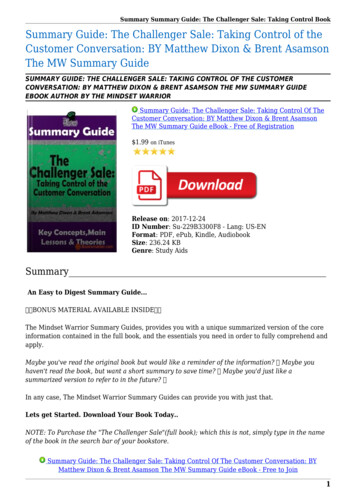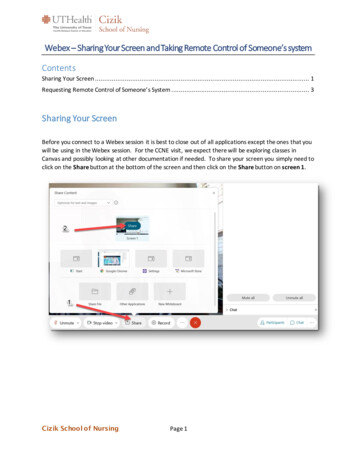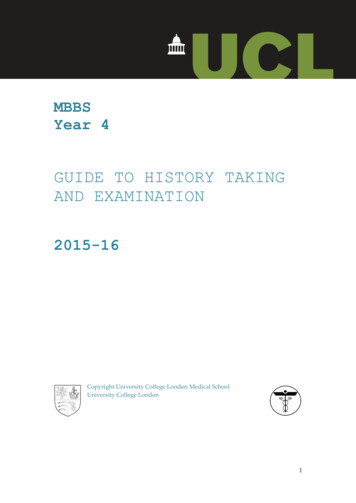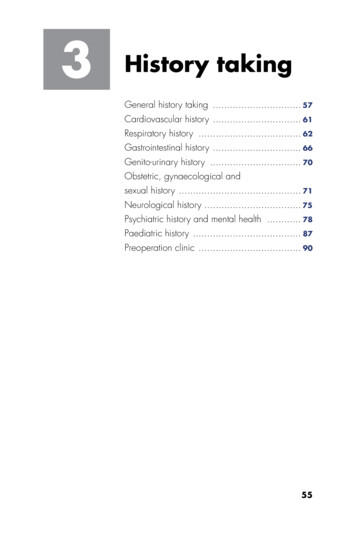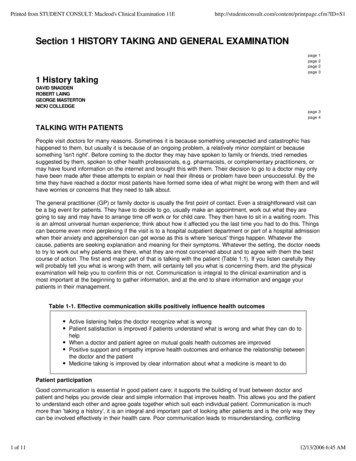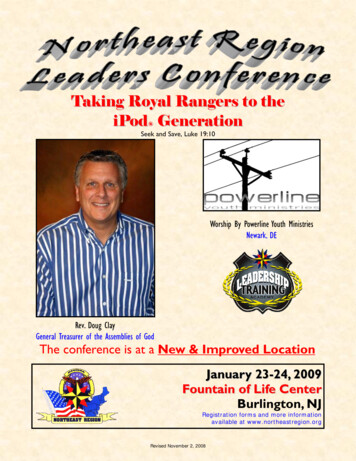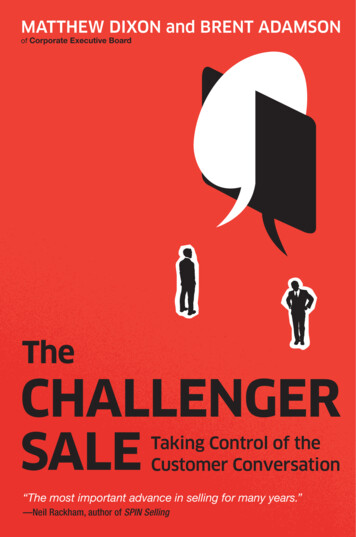
Transcription
MATTHEW DIXON and BRENT ADAMSONof Corporate Executive BoardTheCHALLENGERSALETaking Control of theCustomer Conversation“The most important advance in selling for many years.”—Neil Rackham, author of SPIN Selling
TheChallengerSaleTaking Controlof the CustomerConversationMatthew Dixon and Brent AdamsonPortfolio/Penguin9781591844358 CHALLENGER.indb 39/7/11 10:09 AM
portfolio / penguinPublished by the Penguin GroupPenguin Group (USA) Inc., 375 Hudson Street,New York, New York 10014, U.S.A.Penguin Group (Canada), 90 Eglinton Avenue East, Suite 700,Toronto, Ontario, Canada M4P 2Y3(a division of Pearson Penguin Canada Inc.)Penguin Books Ltd, 80 Strand, London WC2R 0RL, EnglandPenguin Ireland, 25 St. Stephen’s Green, Dublin 2, Ireland(a division of Penguin Books Ltd)Penguin Books Australia Ltd, 250 Camberwell Road, Camberwell,Victoria 3124, Australia(a division of Pearson Australia Group Pty Ltd)Penguin Books India Pvt Ltd, 11 Community Centre, Panchsheel Park,New Delhi – 110 017, IndiaPenguin Group (NZ), 67 Apollo Drive, Rosedale, Auckland 0632,New Zealand (a division of Pearson New Zealand Ltd)Penguin Books (South Africa) (Pty) Ltd, 24 Sturdee Avenue,Rosebank, Johannesburg 2196, South AfricaPenguin Books Ltd, Registered Offices:80 Strand, London WC2R 0RL, EnglandFirst published in 2011 by Portfolio / Penguin,a member of Penguin Group (USA) Inc.1 3 5 7 9 10 8 6 4 2Copyright The Corporate Executive Board Company, 2011All rights reservedChallenger , Challenger Rep, and Challenger Development Program are trademarks andservice marks of The Corporate Executive Board Company. Summary description of Situational Sales Negotiation training and methodology used by permission ofBayGroup International, Inc. SSN Negotiation Planner and 2009 BayGroup International, Inc. SituationalSales Negotiation and SSN are trademarks and service marks of BayGroup International, Inc. Slides from “The Power of Planning the Unplanned” presentation used by permission of W. W. Grainger, Inc.library of congress cataloging in publication dataDixon, Matthew, 1972.The challenger sale : taking control of the customer conversation / Matthew Dixon and Brent Adamson.p. cm.Includes index.ISBN 978-1-59184-435-81. Sales management. 2. Selling. 3. Customer relations. I. Adamson, Brent. II. Title.HF5438.4.D59 2011658.85—dc23 2011026907Printed in the United States of AmericaSet in Adobe Garamond ProDesigned by Pauline NeuwirthWithout limiting the rights under copyright reserved above, no part of this publication may be reproduced,stored in or introduced into a retrieval system, or transmitted, in any form or by any means (electronic,mechanical, photocopying, recording or otherwise), without the prior written permission of both the copyrightowner and the above publisher of this book.The scanning, uploading, and distribution of this book via the Internet or via any other means without thepermission of the publisher is illegal and punishable by law. Please purchase only authorized electronic editionsand do not participate in or encourage electronic piracy of copyrightable materials. Your support of the author’srights is appreciated.9781591844358 CHALLENGER.indb 49/7/11 10:09 AM
ContentsForeword by Professor Neil RackhamixIntroductionA Surprising Look into the Future1 The Evolving Journey of Solution Selling152 The Challenger (Part 1):A New Model for High Performance143 The Challenger (Part 2):Exporting the Model to the Core304 Teaching for Differentiation (Part 1):Why Insight Matters445 Teaching for Differentiation (Part 2):How to Build Insight-Led Conversations656 Tailoring for Resonance1017 Taking Control of the Sale1198 The Manager and the Challenger Selling Model1409 Implementation Lessons from the Early Adopters170 vii9781591844358 CHALLENGER.indb 79/7/11 10:09 AM
Afterwordviii Challenging Beyond Sales187Acknowledgments197Appendix A:Challenger Coaching Guide (excerpt)205 ppendix B:ASelling Style Self-Diagnostic208Appendix C:Challenger Hiring Guide: Key Questions to Askin the Interview210Index215contents9781591844358 CHALLENGER.indb 89/7/11 10:09 AM
ForewordThe history of sales has been one of steady progress interrupted by a few real breakthroughs that have changed thewhole direction of the profession. These breakthroughs,marked by radical new thinking and dramatic improvements in salesresults, have been rare. I can only think of three of them in the lastcentury. The first started about a hundred years ago, when insurancecompanies found that they could double their sales by a simple changein selling strategy. Before this first great breakthrough, insurance policies—in common with many other products such as furniture, household goods, and capital equipment—were sold by salespeople who signedup customers and then every week visited each of them to collect premiums or installment payments. After signing up a hundred or sopeople, the salesperson was too busy collecting weekly premiums to doany more selling of new business. Then some anonymous genius hit onan idea that grew into what we now call the hunter-farmer model. Suppose, instead of one person both selling the policy and collecting thepremiums, the two roles were split. There would be producers, who onlysold, backed up by less experienced—and therefore cheaper—collectors, ix9781591844358 CHALLENGER.indb 99/7/11 10:09 AM
who came behind to look after existing customers and collect the weeklypremiums. The idea was a spectacular success and it changed the insurance industry overnight. The concept quickly spread to other industries,and for the first time selling became a “pure” role, without the burdenof collection.The Second BreakthroughWe don’t know exactly when the producer/collector idea was first introduced, but we can be very specific about the date of the second greatbreakthrough. It happened in July 1925, when E. K. Strong publishedThe Psychology of Selling. This seminal work introduced the idea of salestechniques, such as features and benefits, objection handling, closing,and, perhaps most important, open and closed questioning. It showedthat there were things people could learn that would help them sell moreeffectively, and it gave rise to the sales training industry.Looking back from the sophisticated perspective of today, many ofthe things Strong wrote about sound heavy-handed and simplistic. Nevertheless, he—and those who followed him—changed selling forever.Perhaps the most important aspect of his contribution was the idea thatselling wasn’t an innate ability. It was a set of identifiable skills that couldbe learned. And in 1925, that was radical indeed. It opened selling to amuch wider range of people and, from anecdotal reports of the time,brought about dramatic increases in sales effectiveness.The Third BreakthroughThe third great breakthrough came in the 1970s, when researchersbecame interested in the idea that the techniques and skills that workedin small sales might be very different from those that worked in largerand more complex ones. I had the good fortune to be an integral partof this revolution. In the ’70s I directed a huge research project, tracking 10,000 salespeople in twenty-three countries. We followed salespeople into more than 35,000 sales calls and analyzed what made somex foreword9781591844358 CHALLENGER.indb 109/7/11 10:09 AM
of them more successful than others in complex sales. From this twelveyear project we published a number of books, starting with SPIN Selling. This marked the beginning of what we now call the consultativeselling era. It was a breakthrough because it introduced much moresophisticated models of how to sell complex products and services and,like the earlier breakthroughs, brought about significant gains in salesproductivity.The last thirty years have been marked by a lot of small improvements in selling, but we haven’t seen many game-changing developments that could claim to be breakthroughs. True, there’ve been salesautomation, sales process, and customer relationship management.Technology has played a bigger and bigger role in selling. There havealso been huge changes to transactional selling as a result of the Internet. But all these have been incremental changes, often with questionable productivity gains, and none of them, to my way of thinking,qualifies as a bona fide breakthrough in how to sell differently and moreeffectively.The Purchasing RevolutionInterestingly, there has been a breakthrough development on the otherside of the selling interaction. Purchasing has gone through a majorrevolution. From being a dead-end function in the 1980s where thosewho couldn’t cut it in HR went to die, it has emerged as a vibrant strategic force. Armed with powerful purchasing methodologies such assupplier segmentation strategies and sophisticated supply chain management models, the rise of the new purchasing has demanded fundamental shifts in sales thinking.I’ve been waiting to see how the sales world would react to thechanges in purchasing. If ever there was a time for the next breakthrough, it’s due in response to the purchasing revolution. But nothingbig has appeared on the sales scene. It’s been a bit like waiting for theinevitable earthquake. You know it’s going to come someday, but youcan’t predict when—you just have a feeling that it’s due; something isabout to happen.foreword9781591844358 CHALLENGER.indb 11 xi9/7/11 10:09 AM
The Fourth Breakthrough?Which brings me to The Challenger Sale and the work of the Sales Executive Council. It’s too soon to know whether this is the breakthroughthat we’ve been waiting for: Only time will tell. On the face of it, theirresearch has all the initial signs that it may be game-changing. First,like the other examples, it flies in the face of conventional wisdom. Butwe need more than that. Many crazy ideas violate established thinking.What makes this different is that, like the other breakthroughs, oncesales leaders understand it, they say, “Of course! It’s counterintuitive,but it makes sense. I should have known.” The logic you’ll find in TheChallenger Sale leads to the inescapable conclusion that this is very different thinking and it works.I’m not going to spoil their story by telling either the details or thepunch line. That’s for you to read. But I will tell you why I think theresearch that they have done is the most important advance in sellingfor many years and may indeed justify the rare and coveted label of “salesbreakthrough.”It’s Good ResearchThe research is solid, and believe me, I don’t say this lightly. Much ofthe so-called research in selling has methodological holes so big that youcould fly a jumbo jet through them. We live in an age when every consultant and every author claims “research” to prove the effectiveness ofwhat they are selling. Once research was a sure way to gain credibility;now it’s fast becoming a sure way to lose it. Customers are rightly cynical about unsupportable claims that masquerade under the name ofresearch, such as, “Our research proves that sales more than doubledafter taking our training program,” or “We found in our research thatwhen salespeople used our seven customer buying styles model, it causedcustomer satisfaction to increase by 72 percent.” Claims like these areunprovable assertions that erode the credibility of genuine research.I was at a conference in Australia when I first heard that the SalesExecutive Council had some startling new research on sales effectiveness.xii foreword9781591844358 CHALLENGER.indb 129/7/11 10:09 AM
I must admit that, while I respected the SEC and their good track recordof solid methodology, I had been bitten enough by poor research tothink to myself, “This will probably be yet another disappointment.”When I got back to my office in Virginia, I invited the research team tospend a day with me and we went through their methodology with afine-tooth comb. I admit that I confidently expected to expose seriousflaws in what they had done. In particular, I had two concerns:1. Putting salespeople into five buckets. The research claimed that salespeople fell into one of five distinct profiles:The Hard WorkerThe ChallengerThe Relationship BuilderThe Lone WolfThe Reactive Problem SolverThis sounded naïve and arbitrary to me. What, I asked the team, wasthe rationale for these five buckets? Why not seven? Or ten? They wereable to show me that these were not invented categories but ones thatemerged out of a massive and sophisticated statistical analysis. And theyunderstood, in a way that many researchers don’t, that their five bucketswere behavioral clusters, not rigid personality types. I was satisfied thatthey had passed my first test.2. The high- versus low-performer trap. A large percentage of theresearch into effective selling compares high performers with low performers. In the early years of my own research I did the same thing.As a result I learned a lot about low performers. When you ask peopleto compare their rock stars with their losers, you find that they candissect the losers with surgical precision but find it hard, if not impossible, to put their finger on exactly what makes their rock stars rock.I soon learned that I ended up with a detailed understanding of poorperformance and not much else. If my research was to have any meaning I had to compare top performers with average, or core, performers.It was reassuring to find that the SEC research had adopted exactlythat approach.foreword9781591844358 CHALLENGER.indb 13 xiii9/7/11 10:09 AM
It’s Based on an Impressive SampleIt’s common for sales research to be based on small samples of fifty toeighty participants drawn from just three or four companies. Larger-scaleresearch is harder to do and significantly more expensive. My own researchhad used samples of a thousand or more, not because we liked mega studiesbut because—given the noisy data of real-life selling—we had no choiceif we wanted to draw statistically meaningful insights. The initial sampl
Challenger Sale leads to the inescapable conclusion that this is very dif-ferent thinking and it works. I’m not going to spoil their story by telling either the details or the punch line. That’s for you to read. But I will tell you why I think the research that they have done is the most important advance in selling
